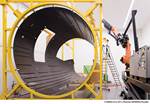ABCs of ultrasonic inspection
A primer on nondestructive ultrasonic inspection technology.
Conventional (non-laser induced) ultrasound (UT) is generated by an element (transducer) made of a piezoelectric material that converts an electrical pulse into a mechanical vibration, which, in turn, induces ultrasonic waves in a test specimen. Any time there is a change in acoustic impedance — such as occurs with a delamination or void — some of the acoustic energy is reflected. The waves that are reflected back to the transducer are converted into a raw electrical signal, measuring amplitude vs. time (think of a seismogram).
For phased-array systems, the probe is composed of multiple elements, which can independently transmit and receive. Time delays are applied to different elements of the probe to focus, steer and scan the beam across the surface. “In the medical field, you can get most of the transmitted ultrasonic energy into our bodies because we are mostly water, but because there is little change in impedance, signal post-processing is often necessary to obtain high-resolution images,” says Deborah Hopkins, BERCLI Corp. (Berkeley, Calif.). “With composites, the issue is strong attenuation caused by inhomogeneity and anisotropy of the material, so you lose energy as a function of distance traveled.” Hopkins says most phased-array ultrasonic applications operate in the range of 2 to 15 MHz.
Related Content
-
Composite combat drone inlet duct proves novel fabrication approach
The 30-foot overbraided Frankenstein demonstrator was designed by NIAR, A&P and Fiber Dynamics to explore more flexible manufacturing of complex composite structures.
-
SCABAEGO project develops bioactive composite that supports healing of broken bones
Fraunhofer IFAM researchers and partners combine biodegradable polymer polycaprolactone and bioactive glass to 3D print custom-fit structures for bone fracture sites.
-
Composites housing improves organ transport to save lives
Vabo Composites collaborates on novel design, supplies lighter, higher volume production housing.


